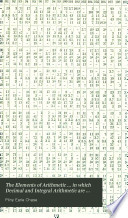 | George Willson - 1838 - 194 σελίδες
...PROBLEM IV. — Given the first term, last term, and common difference, to find the number of terms. RULE. — Divide the difference of the extremes by the common difference, and the quotient increased by 1 is the number of terms. 7. A man travelling a journey, went 18 miles the... | |
 | Benjamin Greenleaf - 1839 - 356 σελίδες
...miles, 2 rods. PROBLEM HI. Given the extremes and the common difference, to find the number of terms. RULE. Divide the difference of the extremes by the common difference, and the quotient increased by one, will be the number of terms required. 9. If the extremes are 3 and 45,... | |
 | Nathan Daboll - 1839 - 220 σελίδες
...yards. CASE IV. TAe first term, last term and common difference given, to find the number of terms. RULE. Divide the difference of the extremes by the common difference, and the quotient increased by 1, will be the number of terms. EXAMPLES. 1 . A man bought cloth in arithmetical... | |
 | Frederick Emerson - 1839 - 300 σελίδες
...miles travelled. PROBLEM in. The extremes and common difference given, to find the number of terms. RULE. Divide the difference of the extremes by the common difference, and add 1 to the quotient; the sum will be the number of terms. The difference of the extremes divided... | |
 | Calvin Tracy - 1840 - 316 σελίδες
...8+1=9, the whole number of terms, or answer required. From the above we derive the following rule : RULE. — Divide the difference of the extremes by the common difference, and add one to the quotient. 2. A man commenced a journey, and traveled the first day only 4 miles ; after... | |
 | Benjamin Greenleaf - 1841 - 334 σελίδες
...miles, 2 rods. PROBLEM IIL Given the extremes and the common difference, to find the number of terms. RULE. Divide the difference of the extremes by the common difference, and the quotient increased by one, will be the number of terms required. 9. If the eXtremes are 3 and 45,... | |
 | 1841 - 200 σελίδες
...CASE IV. Given the first term, the last term, and the common difference, to find the number of terms. RULE. — (') Divide the difference of the extremes by the common difference, and the quotient increased by one is the number of terms required. Question. — 1. The first and last... | |
 | Nathan Daboll - 1843 - 254 σελίδες
...140.) CASE IV. The first term, last term and common difference given, to jind the number of terms. RULE. Divide the difference of the extremes by the common difference, and the quotient increased by 1, will be the number of terms. EXAMPLES. 1. A man bought cloth in arithmetical... | |
 | Pliny Earle Chase - 1844 - 258 σελίδες
...5, gives 7, which must be equal to the number of terms less 1. Therefore the number of terms is 8. RULE. Divide the difference of the extremes by the common difference, and add 1 to the quotient. 13. What is the sum of the series 2, 4, 6,8, &c., to 1000? 14. What is the sum... | |
 | Pliny Earle Chase - 1844 - 246 σελίδες
...5, gives 7, which must be equal to the number of terms less 1. Therefore the number of terms is 8. RULE. Divide the difference of the extremes by the common difference, and add 1 to the quotient. 13. What is the sum of the series 2, 4, 6, 8, &c., to 1000? 14. What is the... | |
| |